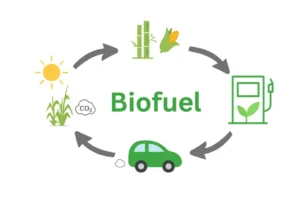GS3 – Environment

Context:
On World Biofuels Day 2025, ethanol blending was highlighted as a key element of India’s energy security, despite challenges related to food, water, and vehicle compatibility.
Challenges Identified (NITI Aayog 2021 E20 Roadmap):
- Food security: Ethanol feedstock may compete with food crops.
- Water usage: Ethanol production is water-intensive.
- Vehicle wear: High ethanol blends can affect engines.
- Fuel efficiency: Slight reduction (~1–2%) in energy output.
Measures to Minimize Food-Fuel Conflict:
- Molasses Utilisation: Preference for B-heavy and C-heavy molasses instead of sugarcane juice.
- Surplus Grain Use: Broken or surplus foodgrains allowed for ethanol production.
- Second-Generation Biofuels: Bamboo (Assam) and seaweed-to-ethanol projects in operation.
- Alternate Crops: Trials with maize, sorghum, and sweet potatoes.
- Policy Shift: Ethanol procurement now offsets surplus sugar exports, benefiting farmers.
- R&D Support: National Bio-Energy Programme funds non-food biofuel innovations.
Measures to Reduce Vehicle Wear & Improve Efficiency:
- E100 Access: Over 400 retail pumps offer pure ethanol; flex-fuel vehicle pilots ongoing.
- Fleet Transition: Gradual rollout of E20-compatible vehicles from 2025.
- Hybrid Flex-Fuel Models: Promotion of plug-in hybrids to optimise ethanol use.
- Pricing Signals: Differential pricing compensates for ethanol’s lower energy content.
- CBG Blend: Targeting 4% CBG in CNG by 2030 to meet renewable fuel goals.
- Sustainable Aviation Fuel (SAF): Panipat refinery converts used cooking oil into low-carbon jet fuel.
Terms:
- E100: Pure ethanol with no petrol content.
- CBG (Compressed Biogas): Purified biogas with methane levels similar to CNG, used as renewable transport fuel.
- SAF: Renewable, low-carbon alternative to conventional jet fuel, derived from biomass or waste oils.




